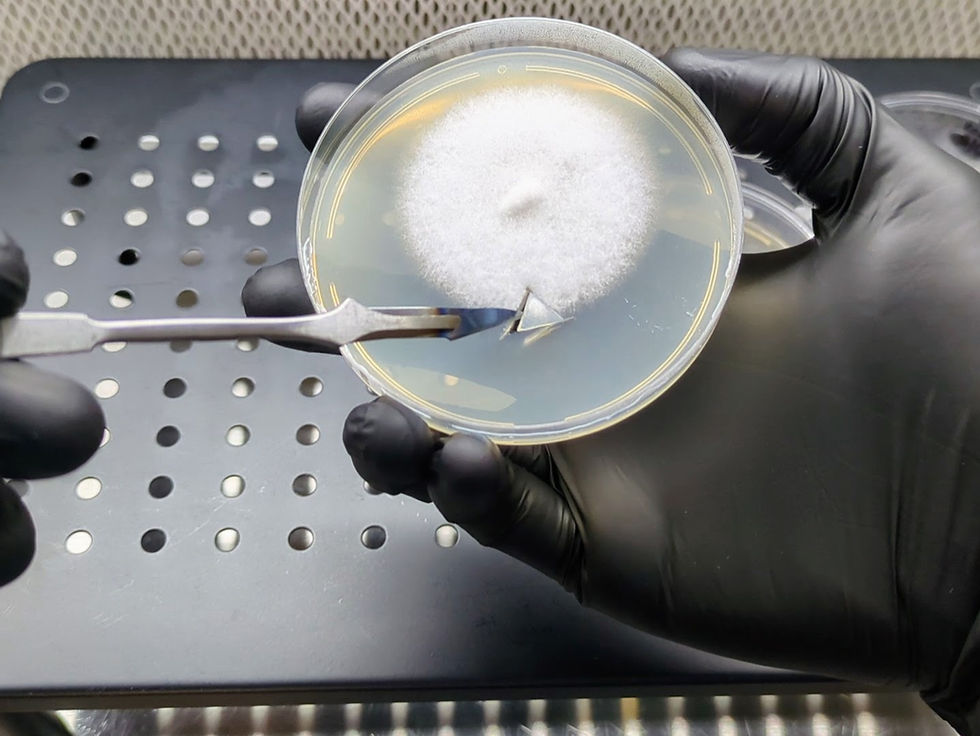How to Build a Monotub: A Reliable Fruiting Solution
- Harold Evans

- Jan 27
- 3 min read
Updated: Oct 15
For home mushroom cultivators, the monotub method is one of the most effective and accessible ways to create the ideal fruiting environment. It balances fresh air exchange and humidity, mimicking the natural conditions mushrooms need to thrive while keeping contamination risks low. Whether you’re a beginner or a seasoned grower, this guide will walk you through building and optimizing a monotub for consistent and successful harvests.

What is a Monotub, and Why Use One?
A monotub is a self-contained growing chamber designed to maintain ideal humidity and gas exchange with minimal effort. By strategically placing ventilation holes and using simple modifications, the monotub allows oxygen to enter while CO₂ escapes, ensuring a healthy fruiting environment.
Advantages of a Monotub:
Low Maintenance: The natural gas exchange minimizes the need for manual fanning.
Cost-Effective: Uses affordable and easily accessible materials.
Scalable: Can be adjusted in size for small or large grows.
Proven Success: Many cultivators rely on this method for consistent mushroom yields.
What You’ll Need to Build a Monotub
Before getting started, gather the following materials:
Plastic Tub: A clear, sturdy container with a lid (32-quart or larger is recommended).
Power Drill: For creating ventilation holes.
Hole Saw or Drill Bits: To cut 1.25–2-inch diameter holes for airflow control.
Micropore Tape or Polyfill: Used to regulate humidity and airflow.
Once you have your materials ready, it’s time to start building!
Step-by-Step Guide to Building Your Monotub
Step 1: Choose and Prepare Your Tub
Select a plastic tub based on your grow size. A 32-quart tub is a great starting point, but you can scale up as needed. Before drilling, clean the tub with soap and water to remove any dust or debris.
Step 2: Drill Ventilation Holes
Proper airflow is key to a successful monotub setup. Follow these steps to ensure optimal gas exchange:
High Holes (Narrow Ends): Drill two holes near the top of the tub, about 1–2 inches below the lid. These allow oxygen to flow in.
Low Holes (Wide Sides): Drill two holes on each long side, roughly 3–4 inches from the bottom. These let CO₂ escape, preventing excessive buildup.
Pro Tip: To ensure precision, fill the tub with water to the expected substrate level and drill just above it.
Step 3: Seal the Holes for Controlled Airflow
Once your tub is filled with inoculated substrate and grain spawn, you’ll need to adjust airflow using micropore tape or polyfill.
Cover the high holes with two layers of micropore tape to allow controlled oxygen intake.
Cover the lower holes similarly, adjusting layers based on environmental humidity:
Drier climates: Add more layers to retain moisture.
More humid environments: Remove layers to enhance airflow.
This simple adjustment ensures a consistent and stable fruiting environment for your mushrooms.
Step 4: Create the Ideal Growing Conditions
Once built, place your monotub in a stable environment with:
Temperature: Maintain 65–75°F (18–24°C) for optimal growth.
Humidity: The enclosed design naturally maintains high humidity, but mist lightly if needed to keep the substrate hydrated.
Light Exposure: Mushrooms don’t require intense light but benefit from indirect natural or 6500K LED lighting for proper fruiting signals.
Unlike other growing methods, there’s no need to fan your monotub manually—the ventilation system handles air exchange automatically.
Tips for Monotub Success
No Fanning Required: The built-in ventilation maintains airflow—just monitor humidity levels.
Fine-Tune Humidity: Adjust micropore tape layers based on environmental dryness or excess moisture.
Monitor the Substrate: Watch for signs of drying or excessive moisture and adjust misting as needed.
Avoid Direct Sunlight: Too much light can overheat the tub—indirect light works best.
Why This Method Works
The monotub method is highly effective because it mimics the natural fruiting conditions mushrooms require while minimizing unnecessary maintenance. By strategically placing ventilation holes and using a well-sealed environment, you ensure:
Steady oxygen flow to promote healthy fruiting.
CO₂ regulation to prevent stunted growth.
Consistent humidity for successful pinning and development.
This method has been used successfully by growers for years, making it a trusted, low-effort solution for cultivating mushrooms at home.
Final Thoughts: Ready to Grow?
Building a monotub is one of the simplest ways to cultivate mushrooms while maintaining control over environmental factors. Its reliable, self-regulating design makes it an excellent choice for growers of all experience levels.
By following this guide, you’re setting yourself up for a consistent and successful mushroom harvest. Whether you’re growing for personal use or expanding your skills, the monotub method offers a straightforward, efficient, and highly effective approach to home cultivation.




Comments